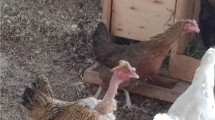Summary
The effects of varying intensities of selection at first and second stages, for a given final intensity, on the efficiency of two-stage index selection are described. Data collected on four White Leghorn strains for part and residual egg number, body weights at 20 and 40 weeks and egg weight at 39 to 40 weeks were utilised. Four of the five traits were used in the first stage and all five traits were used in the second stage for the construction of two-stage selection indexes. The index that utilised all five traits had the maximum efficiency for one-stage selection. The relative efficiency of the two-stage index increased with increase in proportion selected at the first stage. A practical breeding schedule that adds the advantage of reduced generation interval by utilising a two-stage index selection is suggested for egg type chickens.
Similar content being viewed by others
References
Abdou FH, Kolstad N (1979) Two stage selection in White Leghorn hens. Acta Agric Scand 29:93–97
Cunningham EP (1975) Multi-stage index selection. Theor Appl Genet 46:55–61
Flock DK (1977) Genetic analysis of part period egg production in a population of White Leghorns under long-term RRS. Z Tierz Züchtungsbiol 94:89–103
Gowe RS (1977) Multiple-trait selection in egg stocks. 1. Performance of six selected lines derived from three base populations. 2. Changes in genetic parameters over time in the six selected strains. In: Proc 26th Annu Nat Breed Roundtable Poultry Breed America. Kansas City Mo, pp 68–91
Gowe RS, Fairfull RW (1980) Performance of six long-term multitrait selected Leghorn strains and three control strains and a strain cross evaluation of the selected strains. In: Proc 1980 South Pac Poultry Sci Conv. World's Poultry Science Association, New Zealand Branch, Auckland, pp 141–161
Gowe RS, Lentz WE, Strain JH (1973) Long-term selection for egg production in several strains of White Leghorns. Performance of selected and control strains including genetic parameters of two control strains. In: Proc 4th Eur Poultry Conf. British Poultry Science Ltd, London, pp 225–245
Harvey WR (1966) Least squares analysis of data with unequal subclass numbers. USDA-ARS 20:1–157
Lerner IM, Cruden DM (1948) The heritability of accumulative monthly and annual egg production. Poultry Sci 27:57–78
Morris JA (1964) The usefulness of early records as selection criteria. In: Proc 1964 Australian Poultry Sci Conv. Suffer's Paradise, Queensland, pp 7–11
Sharma RP, Mohapatra SC (1982) Efficiency of two-stage index selection for selection of broiler parents. Indian J Poult Sei 17:157–163
Author information
Authors and Affiliations
Additional information
Communicated by H. Abplanalp
C.A.R.I. Publication No. 26/83
Rights and permissions
About this article
Cite this article
Ayyagari, V., Mohapatra, S.C., Bisht, G.S. et al. Efficiency of one- and two-stage selection indexes for improvement of net economic merit in White Leghorns. Theoret. Appl. Genetics 70, 166–171 (1985). https://doi.org/10.1007/BF00275317
Received:
Accepted:
Issue Date:
DOI: https://doi.org/10.1007/BF00275317




